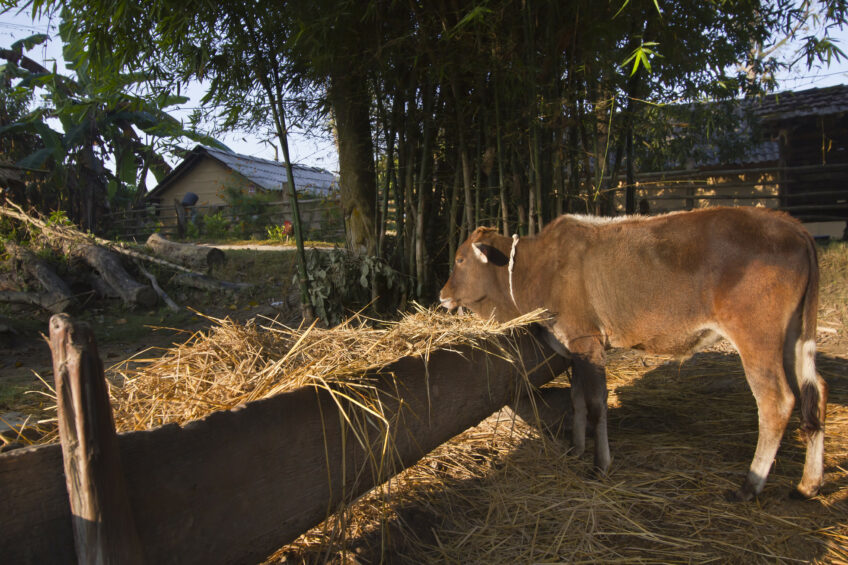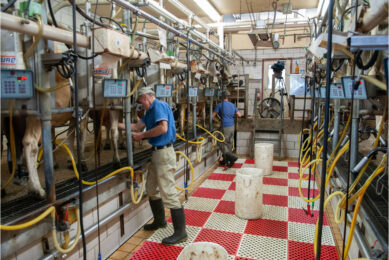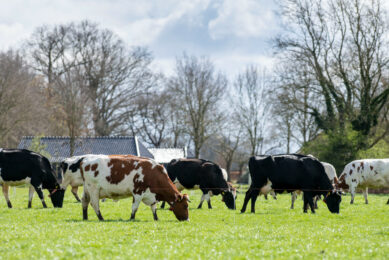Cattle farming in Nepal: Why farmers cry

Dairy farming in Nepal is not a money-making business. The farmers struggle with low milk production per cow and poor farming conditions. However, initiatives have been set up to help change this situation.
According to statistics from the Ministry of Livestock Development, there are 7.2 million head of cattle and 5.4 million head of buffalo in Nepal. In 2016, 3,000 dairy farms and 424 buffalo farms were registered. Around half of the number of dairy farms are really small, and have around five to ten animals per farm. A small amount have more than 20 animals and only ten farms have 100-500 cattle. The country produces 1.9 million litres milk per day, whereas the demand is 2.4 million litres. The country is therefore importing milk from India. At the same time, most of the (raw) milk is consumed by farmers and doesn’t reach the market.
Lack of pure breeds
Only 5% of the cattle in Nepal are considered pure breeds, like Holstein and Jersey. Farmers therefore use artificial insemination (AI) to mix Holstein and Jersey cattle with their local cattle. The idea to cross-breed with high producing breeds such as Holstein is to boost production of local breeds. However, Nepalese farmers often only reach between 500 to 2,000 litres per cow per year. The productivity of buffalo is also not very high. Cross-bred animals give 5 litres milk per day, against the 3 litres from local breeds.
The low daily production results in a low income for pretty much all Nepalese cattle farmers. Dairy farmer Ram Bahadur Gautam has 350 dairy cows in Patlekhet (western-central Nepal). His herd produces only 1500-1800 litres per day. “The income I generate is not enough to pay my staff and production costs. The cause of the problems are down to the lack of pure breeds, quality of the bull semen and nutrition,” the farmer explains. An additional problem is that Nepal is experiencing a lack of manpower. Most of the young people go abroad, to work in the Gulf countries for example. Most of the work on the farm is done manually, adding up to the production costs of the milk and young people don’t want to do this kind of job any more. They would rather move to the city areas or to other countries.

Feed management is key
As explained above, one of the problems is feed management. Only 10% of commercial farms use outdoor grazing, due to the lack of good grazing pastures in Nepal. Pradeep Raj Pant, owner of Destination Agro Farm, a big cattle farm in Bhaktapur explains that they use both industrial pelleted feed and forage (in a 50/50 ratio). They provide feed twice a day and supply 0.5 kg concentrates per litre of milk. The remaining feed is supplied in the form of fodder and hay. They make different feed rations for pregnant cows, calves and lactating animals, based on the analyses of their needs and health status. Generally, the amount of feed is 15% of the animals’ body weight. For example, if an animal is 400kg, it gets 60kg feed per day. Water is also an essential to keep the cows healthy and productive. The farm provides an average of 90 litres water per cow per day. ”Dehydration in the animals result in a big drop in milk production. We have learned that many health problems are the result of dehydrated cows,” he explains. Due to proper feed management, the animals at Destination Agro Farm don’t need a lot of veterinary treatment, hence saving Pant and his staff a lot of money. “We are convinced that proper feed is a preventive measure for most diseases,” he says.
Limited access to veterinary drugs
The farms that do use veterinary treatment for the animals do not always have access to good treatment options. The right type of medication and treatments is not taken for granted in local markets and often cattle remain sick because there is simply no right treatment available. Santosh Subedi, manager of Kantipur Vet Distributors in Kathmandu says that selecting and distributing world class veterinary medicines has some challenges. His company is a leading veterinary medicine importer and trader of Nepal, but he cannot always import what he needs. “We have no easy access to world class leading veterinary medicine producers directly, so we have to rely on those companies who are more closely situated to us. Most of the veterinary medicines that are used in Nepal therefore come from India and just a very small amount is imported from countries such as the Netherlands, Germany, Belgium, Italy, US, etc. “We also face some risks by importing the medicines, as sometimes the packages leak or break or have gone over the expiration date. When this happens we don’t get any compensation and subsidy from the companies,” Mr Subedi says.

Government initiatives
Although, in theory, Nepal has many opportunities in terms of production and export, there are too many hurdles that prevent the country’s dairy sector from flourishing. Export of animal products is not easy, although dairy products and processed meat have good scope for international trade. “Buffalo meat (buff in Nepal) is exported to nearby countries, but the local companies cannot fulfil demand. We have plenty of livestock, poultry and farm land, but many of internationally recognised companies don’t see this or are not aware of it,” Mr Subedi says. He continues: “The approach to open up to international markets is difficult for Nepal and we simply do not have enough technical and experienced people to make this happen.” Nevertheless, the Nepalese government has started a couple of initiatives to help the local cattle farmers, mainly focused on breeding and genetics to boost milk production. The Ministry of Livestock Development has been giving subsidies to apply artificial insemination (AI) on local farms. This way, poor farmers can also use AI for their herds. All of the governmental livestock service offices and private veterinarians are able to supply AI services. Each year, about 0.6 million cattle receive AI. In addition to this, since last year, the ministry has been testing and applying embryo transfer in cattle. Embryos from cross-breeds are transferred to other cattle, hence producing a better yielding calf. This method has a success rate of around 30%. To step up feeding practices, the government has also been offering forage to farmers at a lower price. The production cost of milk is higher than the milk price, and this is mainly the result of the high costs of concentrated feed (feed pellets). “The government is therefore keen to promote forage based cattle production and has been providing quality forage seed to farmers at a low price,” explains Dr Nirmal, director general of the Department of Livestock. “In 5 years from now we want to increase the forage land area to 4,500 hectares,” he said. Currently, about 26% of the cattle are unable to get feed (they search fodder and scraps on the side of the road) and 64% of the cattle do not get a balanced feed ration. This means that only about 5 to 10% of the cattle are lucky enough to get a proper diet.
Bull calves should be nurtured
Nepal was declared a secular country by the Parliament on May 18, 2006. Religions practised in Nepal are: Hinduism, Buddhism, Islam, Christianity, Jainism, Sikhism, Bon, ancestor worship and animism. The majority of Nepalis are either Hindus (80%) or Buddhist. The 2 have co-existed in harmony throughout the centuries.

In the Hindu culture, it is strictly prohibited to raise and slaughter cattle for the purpose of meat production. This is because the cow is considered sacred and an incarnation of the goddess Lakshmi (goddess of wealth). In practice, this means that bull calf and cow management is very challenging. The bull calves should be kept on the farm and fed until they die. The same accounts for oxen and non-productive female cows. “This is why it is very important for the Nepalese dairy farmers to use sexed semen to inseminate the cows, but sexed semen is not readily available in Nepal, and if it is, it’s very expensive”, explains Pradeep Raj Pant, owner of Destination Agro Farm. A decade ago, oxen were used to plough land and pull carts. These practices are almost non-existant nowadays and have been replaced by machines. Often, bull calves and non-productive cattle are abandoned and found at the side of the road. The government has therefore made shelters in cities and in some temples. Non-productive cattle are kept there and their dung is sold for cultivating the land.
Join 13,000+ subscribers
Subscribe to our newsletter to stay updated about all the need-to-know content in the dairy sector, two times a week.










